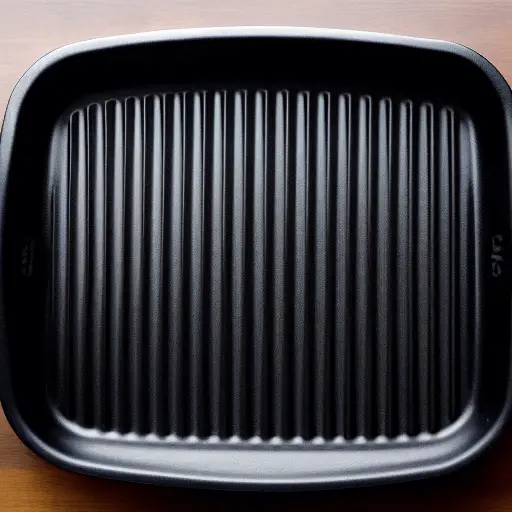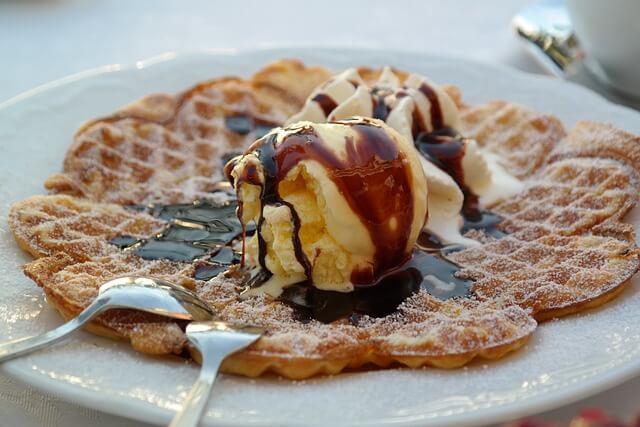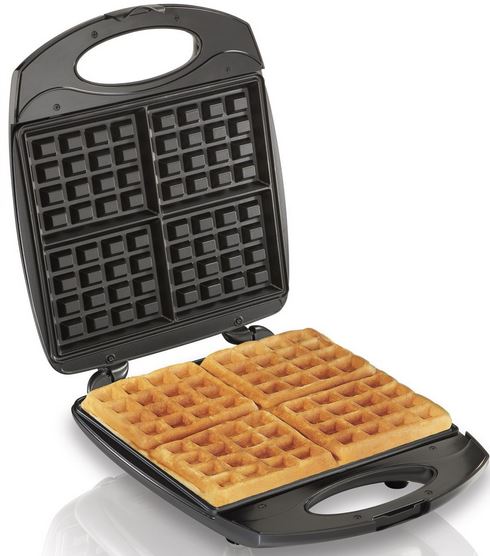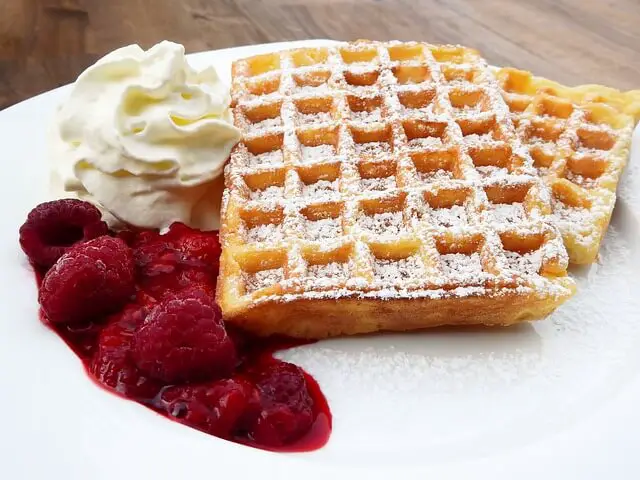This article will attempt to answer the question ‘Why are my Belgian Waffles So Dry and Chewy?’.
Belgian waffles have a soft and fluffy interior and a slightly crispy outer crust that is sturdy enough to hold toppings including strawberries and syrup. Regular waffles are denser, heavier, and less crispy and thick than the Belgian waffles from a 2 inch thick Belgian waffle maker. Belgian waffles originated in Belgium and they were very popular back then and remain popular to this very day. It is also a very popular breakfast option in the United States and Canada. You should buy one of the best rated Belgian waffle makers with removable plates to make your Belgian waffles because cleaning up will be much easier since you can remove and clean the plates in a dishwasher. However, there are times when the waffles from your Belgian waffle maker can come out dry and chewy.
There are several reasons why your Belgian waffles are dry and chewy including over-mixing your batter, not adding enough eggs or vegetable oil, or using the wrong type of flour.
Table of Contents
- 1 Lack of moisture can make your Belgian waffles too dry
- 2 Waffle iron is not preheated long enough
- 3 Waffle iron temperature is set too high
- 4 Overmixing causes too much gluten development
- 5 Not adding enough eggs or vegetable oil
- 6 Using the wrong type of flour
- 7 Too Much Salt in the Batter
- 8 Waffle maker is too hot
Lack of moisture can make your Belgian waffles too dry
One possible reason your waffles turn out too dry is that you are not adding enough moisture to the batter which means all of the moisture in the batter will evaporate too soon and the dried-out batter will continue to cook on the plates before they have completely cooled off, resulting in an overly dry waffle.
This can be caused by using too much flour or by not using enough wet ingredients like eggs, milk, melted butter, or oil.
Waffle iron is not preheated long enough
Another reason your waffles turn out too dry is that your waffle iron is not preheated long enough which means it will not be hot enough to cook your batter unevenly so your waffles will come out dry.
Be sure to preheat your iron for at least 5 minutes before you start cooking the waffles. Use an oven thermometer to check the temperature of your iron before making waffles to ensure that it is properly preheated or you can try cooking the waffles for a shorter amount of time.
Also make sure to use some extra oil or butter when cooking the waffles, as this will help them stay moist.
Waffle iron temperature is set too high
When making Belgian waffles at home, the temperature of the waffle iron is important for ensuring that they have a moist fluffy interior and crispy exterior. However, if the temperature is set too high, it can cause the waffles to turn out dry.
The reason why this happens is that when the temperature is too high, it causes the water in the batter to evaporate too quickly, which results in a drier waffle.
Also high temperatures can cause the sugar in the batter to caramelize too quickly and cause the outside of the waffle to cook too quickly, which results in a dry and crispy texture while leaving the inside undercooked.
Therefore, when making Belgian waffles at home, it is important to make sure that you keep an eye on the temperature and adjust it as necessary depending on your particular waffle iron.
Make sure to follow the recipe closely, and adjust the heat setting as needed. If your waffles are still dry after trying these tips, then you may need to invest in a better waffle maker.
Overmixing causes too much gluten development
Amount of mixing, type of flour, amount of water, and presence of fats are amongst the factors that can affect the gluten formation in your waffles.
One potential reason your Belgian waffles come out too dry and chewy is because of the gluten that forms when flour and water are mixed together. Wheat, barley, rye, and other related grains contain glutenin and gliadin proteins. When you grind these grains to create flour and mix it with water, the two proteins will combine to form gluten.
The more you mix your Belgian waffle batter, the more the water is dispersed throughout the flour, causing more gluten to be developed. This causes the batter to become elastic and stretchy, as can be seen in bread dough. However, too much gluten can make your baked goods rubbery and tough.
When you over-mix waffle batter, the gluten can become overdeveloped and make your waffles dry, tough, and chewy. In order to avoid this, be careful not to mix the batter for too long – just until all of the ingredients are combined. Try to gently fold the flour into the batter until you don’t see any flour in the batter.
Gluten is important because it gives structure to baked goods, including waffles, cakes, and cookies. Gluten is a stretchy, springy network of proteins, found in grains such as wheat and rye, that holds the ingredients of bread together and gives it a light and fluffy structure, instead of a dense, crumbly cookie structure. It’s a tangle of proteins that gives bread dough the strength to hold its shape and rise in the oven, trapping gas bubbles in a stretchy mesh. It also makes crusts from pizzas chewy.
Gluten acts as a binder. Without gluten, baked goods would not have the structure necessary to hold their shape and would be very crumbly. It holds ingredients together and allows them to be stretchy. It gives Belgian waffle batter its elasticity and extensibility and helps make pizza crusts sturdy. Without gluten, many baked goods would not be properly formed because they would not hold their shape or be crispy enough. If there is not enough gluten, a pizza maker would not be able to toss and stretch a ball of dough because the pizza dough would break apart too easily.
The formation of gluten can be seen during the kneading of bread dough. Kneading causes the gluten strands to get stronger and longer. However, if too much gluten is formed, then the bread dough does not stretch so easily. This will cause the bread to become tough and chewy. Relaxing or resting the dough reduces its elasticity, making it easier to roll out.
Unlike bread dough, pastry dough is only mixed until all the ingredients are combined resulting in less gluten development. However, if there is too little gluten in the pastry dough it will fall apart easily.
Not adding enough eggs or vegetable oil
The fats from shortening, oils, and egg yolks can prevent gluten development by creating a coating around the gluten proteins to prevent them from absorbing water which will prevent the gluten proteins from sticking to each other, slowing down the formation of gluten. This will break down the gluten proteins into shorter strands, preventing them from forming long, strong strands that can make waffles hard and tough.
Using the wrong type of flour
Different types of flours contain varying amounts of protein content which will affect the texture of your baked goods. The protein content is expressed as a percentage and represents the number of grams of protein per 100 grams of flour. The protein content percentage can normally be found on the back of the flour packaging along with the other nutritional information.
Bread flour has a high protein content percentage of about 14%, which means it is a stronger flour that is ideal for making chewy bread but is too heavy for making waffles. Pastry flour has a low protein content percentage of about 8% which means it is a softer flour that is more suited for baked goods with a crumbly or flaky texture, including pie crusts, muffins, and cookies.
If you want your waffles to turn out the right way, you have to use flour that does not have too much or too little protein content. This means that you should be using all-purpose flour to make your waffles because it has a protein content percentage that ranges from 9% to 12%.
Too Much Salt in the Batter
Everyone knows that you add salt to enhance the flavor of your ingredients. However, not everyone knows that adding too much salt can strengthen gluten bonding too much which can make your waffles too dry and chewy. Gluten proteins are repulsed by one another, but the addition of chloride ions from salt can help them overcome that repulsion.
When mixed with a liquid, gluten proteins naturally repel one another. This is because their individual gluten strands have a positive electrical charge and they are repelled by other positive charges. However, when salt is added to the mix, it contains chloride ions which have a negative charge. This overcomes the natural repulsion of the gluten proteins and causes them to stick together. This is why adding salt to the dough helps it to rise and become fluffy because adding salt to the mix will tighten the dough up which is caused the increased strength of the gluten.
The result is a more stable gluten network in the dough, which gives bread its structure and prevents it from crumbling. In fact, without salt, bread would not rise very much because the gluten network would break down too easily which will make the bread crumbly and dry.
Waffle maker is too hot
Another possibility is that the yeast in the batter needs more time to rise and form air bubbles which will make the waffles light and fluffy. If the waffle iron is too hot, it can cook the waffles too quickly and get rid of all the moisture in the waffle batter before they have a chance to rise, leaving you with dry and tough waffles.




